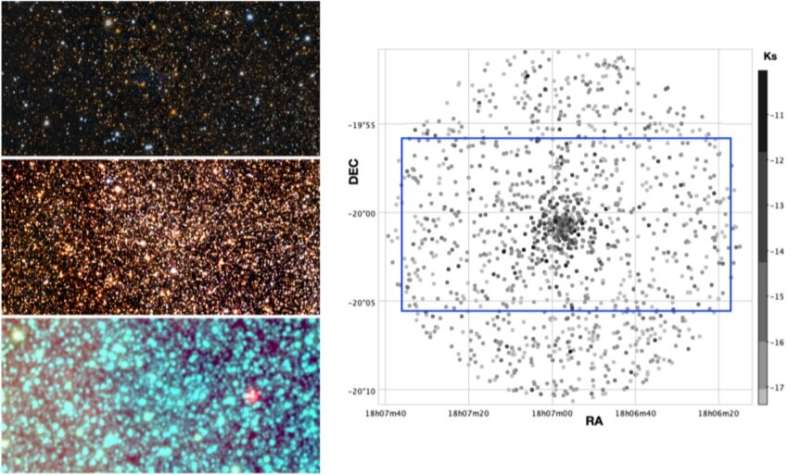June 10, 2021 report
New globular cluster exhibiting extreme kinematics detected

Astronomers from the Andrés Bello National University, Chile, and elsewhere, have discovered a new nearby globular cluster (GC) with extreme kinematics. The newly found cluster, designated VVV-CL160, has an unusually large proper motion when compared to other galactic GCs. The finding is reported in a paper published on arXiv.org.
Globular clusters are collections of tightly bound stars orbiting galaxies. Astronomers perceive them as natural laboratories enabling studies on the evolution of stars and galaxies. In particular, globular clusters could help researchers better understand the formation history and evolution of early type galaxies, as the origin of GCs seems to be closely linked to periods of intense star formation.
VVV-CL160 was initially detected as an old open cluster in 2014 as part of the VISTA Variables in the Vía Láctea (VVV) survey. It was estimated that the object is about 1.6 billion years old, has a metallicity at a level of approximately -0.72, and is located some 17,100 light years away from the Earth.
Now, a new study led by Dante Minniti reports that VVV-CL160 is actually a GC and sheds more light on its properties. The research is based mainly on the data from the VVV Infrared Astrometric Catalog (VIRAC2) and from ESA's Gaia satellite.
"In this letter, we analyze VVV-CL160, which we argue is a new nearby GC; it was found in the VVV survey data by Borissova et al. (2014)," the astronomers wrote in the paper.
The study found that VVV-CL160 is concentrated, with a core radius of about 1.43 light years and a tidal radius of some 189 light years. The total luminosity of this cluster was estimated to be -7.6 mag and its metallicity was measured to be at a level of -1.4.
VVV-CL160 was found to be much older than previously thought as its age was calculated to be 12 billion years old. Moreover, it turns out that the cluster is closer to Earth than it was assumed—its distance to our planet is approximately 13,000 light years.
The most interesting feature of VVV-CL160 is its peculiar proper motion different from that of the rest of the galactic GCs—with the exception of NGC 6544, which appears to have similar kinematics.
"VVV-CL160 has an unusually large PM for a galactic GC as measured with VIRAC2 and Gaia EDR3: µα cos(δ) = −2.3±0.1 mas/yr and µδ = −16.8 ± 0.1 mas/yr. The kinematics are similar to those of the known GC NGC 6544 and the Hrid halo stream," the astronomers explained.
The researchers concluded that the location and kinematics of VVV-CL160 indicate that this cluster may be associated with the extension of the Hrid halo stream (recently discovered in the northern hemisphere). They added that if this hypothesis is true, it would mean that the Hrid stellar stream is significantly longer than previously thought and may even be a fully fledged dwarf galaxy that is being accreted by the Milky Way.
More information: Discovery of a new nearby globular cluster with extreme kinematics located in the extension of a halo stream, arXiv:2106.01383 [astro-ph.GA] arxiv.org/abs/2106.01383
© 2021 Science X Network




















